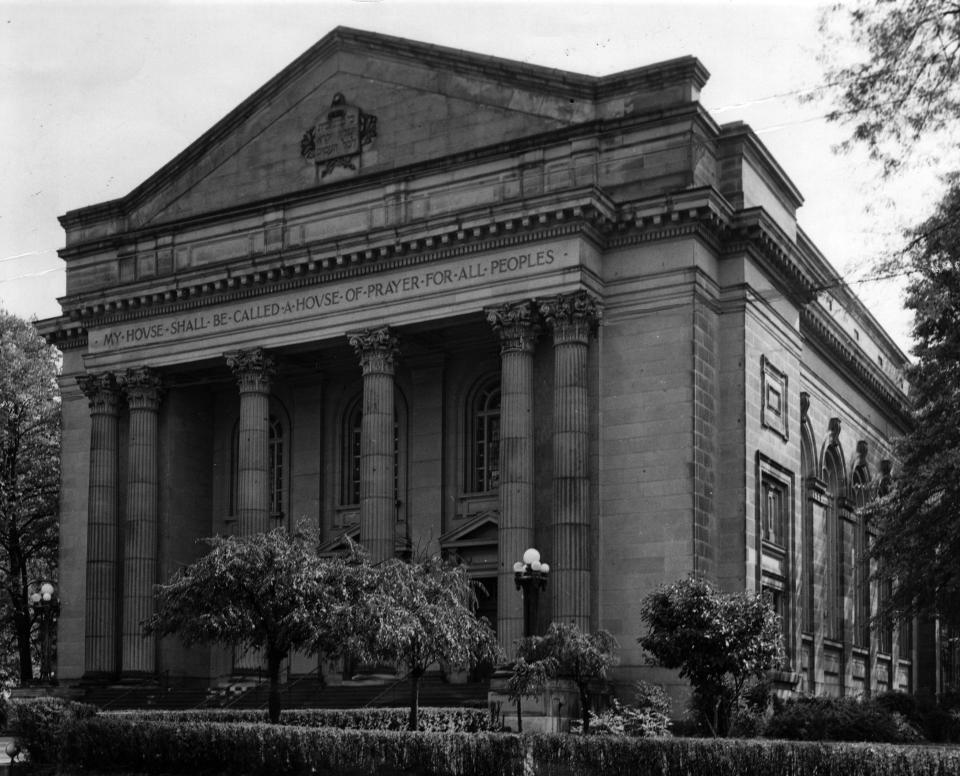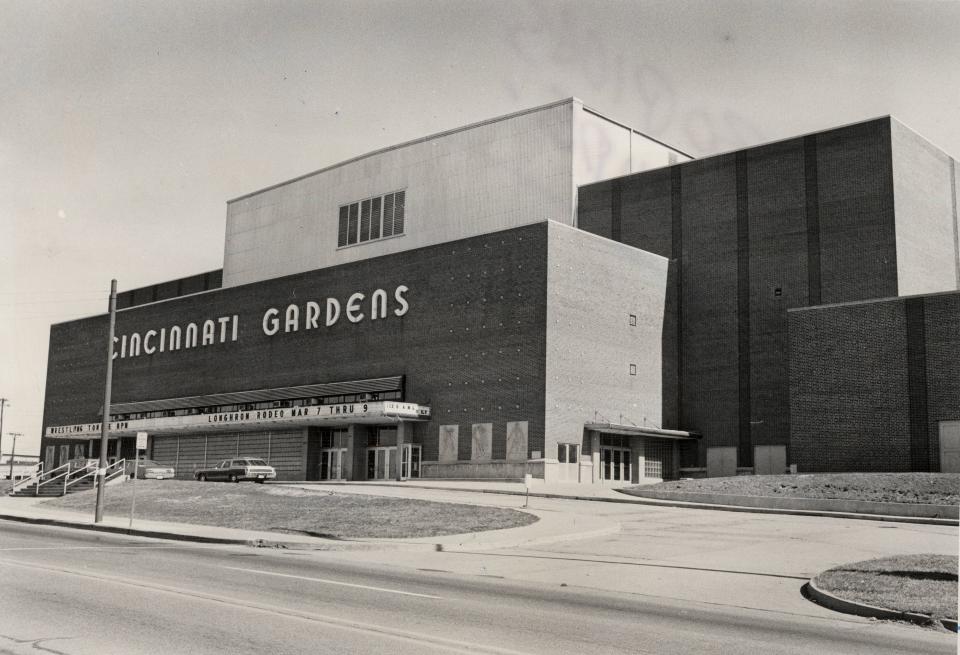Cincinnati’s historic anniversaries of 2024, from tornadoes to boxing titles
- Oops!Something went wrong.Please try again later.
As we move into 2024, there are several notable anniversaries in Cincinnati’s history coming up in the new year.
In 2023, we remembered the 150th anniversary of the May Festival (the oldest choral festival in the Western Hemisphere), the 75th anniversary of the modernist Terrace Plaza Hotel, and 100 years since General Motors opened a plant in Norwood (which closed 64 years later).
It will be much the same in the new year as we mark a significant milestone for a grand institution, the anniversary of a triumph and the wistful passing of two lost treasures, as well as a somber remembrance of one of the worst tragedies that has ever befallen this region.
Rockdale Temple founded – 200 years ago
Rockdale Temple is celebrating 200 years since its founding, making it the oldest Jewish congregation west of the Alleghenies and one of the oldest in the U.S.
When Cincinnati was still a frontier town, a handful of Jewish settlers first established a cemetery, per Judaic law – Chestnut Street Cemetery in West End in 1821. Then they organized the congregation K.K. Bene Israel (meaning the Holy Congregation of the Children of Israel) in January 1824.

Bene Israel has had several synagogues over the years, starting in Downtown at Sixth and Broadway, then Mound Street, then the corner of Rockdale and Harvey avenues in Avondale. Over the decades, they more commonly identified as the Rockdale Temple, and that name carried with them when the congregation moved to Amberley Village in 1969.
There will be more to come soon on Rockdale Temple’s history as they celebrate with a bicentennial gala on Jan. 27. Stay tuned.
Old Main Library opened – 150 years ago
Cincinnati’s public library finally got its own home in the 1870s. Before that, the collection shared space with the library of the Ohio Mechanics Institute in the old Greenwood Hall at Sixth and Vine streets. (That’s when a young telegraph clerk, Thomas Alva Edison, would sit in the OMI building and read every book he could find on electricity.)
The school board, which oversaw the public library at the time, acquired Thomas B. Handy’s unfinished opera house under construction on Vine Street. The building was just a shell when Handy ran out of money. The board asked architect James W. McLaughlin to complete the building, working with librarian William F. Poole to convert the design into a library.
The library opened in stages. The front building, what was to be the opera house, opened to the public on Dec. 9, 1870. But it was the stunning main hall that was really memorable when it opened on Feb. 25, 1874.
Patrons stepped through a vestibule and entered the cathedral-like main hall straight out of a Harry Potter story. Four stories tall, with towering iron bookshelves, complete with spiral staircases, lined up like dominoes on a checkerboard marble tile floor. All topped by a massive skylight roof that let in shafts of sunlight.
“The main hall of the building is a splendid work,” The Enquirer wrote about the dedication. “... The hollow square within the columns is lighted by an arched clear roof of prismatic glass set in iron, the light of which is broken and softened by a paneled ceiling of richly-colored glass. ... One is impressed not only with the magnitude and beauty of the interior, but with its adaptation to the purpose it is to serve.”
The Old Main Library is one of Cincinnati’s lost treasures. It wasn’t really a practical library – too small for the collection with poor ventilation and hard-to-navigate stairs. And the Victorian-era design was not valued in the mid-20th century. So, it was replaced by the current Main Library – designed more like a modernist department store – and torn down in 1955.
Cincinnati Gardens opened – 75 years ago
Here’s another historic site that has been lost. Cincinnati Gardens opened at 2250 Seymour Ave. in Bond Hill on Feb. 22, 1949, as a multi-use indoor venue for sports, concerts, speeches and even Ice Capades. The name was originally the Cincinnati Garden – the “s” started appearing in news stories in 1958.

The $3 million arena (about $38 million in 2023 dollars) was inspired by Toronto’s Maple Leaf Gardens without the dome. The building entrance featured six bas-relief figures representing basketball, hockey and boxing, designed by Art Academy of Cincinnati student Henry Mott.
Cincinnati Gardens hosted many historic moments: The Beatles in 1964, Elvis Presley in 1971 and 1973, plus Martin Luther King Jr., Richard Nixon and Evel Knievel.
From 1957 to 1972, the Gardens was the home of the Cincinnati Royals NBA team, where Oscar Robertson racked up points. It also held Crosstown Shootouts, Ezzard Charles bouts, Mighty Ducks hockey and the Cincinnati Rollergirls.
But the aging arena closed in 2016 and was torn down in 2018. The famous lettering spelling out Cincinnati Gardens was acquired and repurposed by the American Sign Museum in Camp Washington. The sculptures were also saved, with a couple of them also at the sign museum.
Ezzard Charles wins heavyweight title – 75 years ago
Speaking of Ezzard Charles, the Cincinnati Cobra – who grew up in West End – scored a split decision against Joey Maxim at Cincinnati Garden on Feb. 28, 1949, (a week after the venue opened) that gave him a chance to challenge Joe Louis for the heavyweight boxing title. But Louis retired that year, and the title was up for grabs.
On June 22, 1949, Charles triumphed over Jersey Joe Walcott in a 15-round decision in Chicago, while his family watched the bout on television in the living room of the boxer’s home on Lincoln Park Drive.
When the announcer’s voice came through the television, “The winner and new heavyweight champion of the world, Ezzard Charles,” his family jumped up and down and hugged. Charles’ great-aunt Lenora Russell shouted, “We gotta champ. We gotta champ!”
Charles held the heavyweight title until losing in 1951. He was later diagnosed with amyotrophic lateral sclerosis (ALS) and died in 1975. A 13-foot bronze statue of Charles was dedicated in West End in 2022.
Tornado outbreak hit – 50 years ago
What the National Weather Service calls “the worst tornado outbreak in U.S. history” hit the Midwest over April 3 and 4, 1974. During the Super Outbreak, as it is known, 148 tornadoes tore across 13 states, leaving 335 dead and 6,000 injured.
Ohio, Kentucky and Indiana were the hardest hit, with 159 deaths and some of the worst damage.

Xenia, Ohio, east of Dayton, was devastated by an F5 tornado, the highest measure on the Fijuta scale. Winds of 300 mph ripped through town, killing 32 people and damaging thousands of homes.
An F5 tornado also touched down in Sayler Park, killing four people. It also caused extensive damage in Dent, Roselawn, Mason and Blue Ash.
After the tornadoes, President Richard Nixon visited Xenia and declared it a disaster area. He later said that the outbreak contributed to getting the Disaster Relief Act of 1974 passed through Congress.
Sources: Enquirer archives, “Free & Public: One Hundred and Fifty Years at the Public Library of Cincinnati and Hamilton County, 1853-2003” by John Fleischman, “Lost Cincinnati,” National Weather Service.
This article originally appeared on Cincinnati Enquirer: Cincinnati’s historic anniversaries coming in 2024

